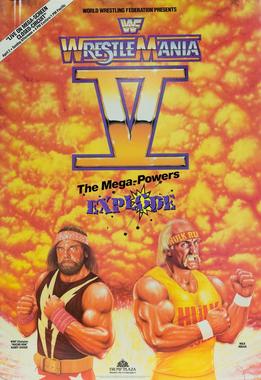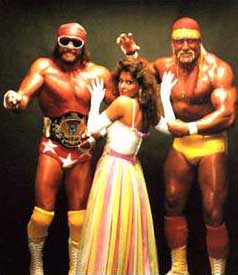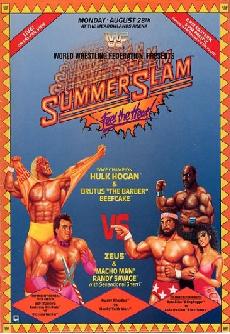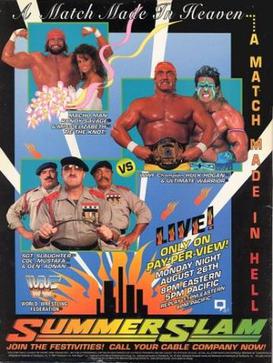
The Main Event is an American series of professional wrestling television specials that were produced by the World Wrestling Federation (WWF). The Main Event was a spin-off of Saturday Night's Main Event and was held only one time in a year and was equivalent to today’s monthly pay-per-view (PPV) events. Like Saturday Night’s Main Event, The Main Event aired late and held its main event match on the first hour of the show. There were five shows between 1988 and 1991. Only the first three The Main Event episodes were shown live on NBC. The final two were taped and then shown on NBC at a later date. It included mainly high-card wrestlers of the WWF including Hulk Hogan, André the Giant, "Macho Man" Randy Savage, The Ultimate Warrior and "Million Dollar Man" Ted DiBiase.

WrestleMania IV was the fourth annual WrestleMania professional wrestling pay-per-view (PPV) event produced by the World Wrestling Federation. The event took place on March 27, 1988, at Boardwalk Hall in Atlantic City, New Jersey. The announced attendance of the event was 19,199, drawing a 6.5 buyrate on PPV.

WrestleMania V was the fifth annual WrestleMania professional wrestling pay-per-view (PPV) event produced by the World Wrestling Federation. It took place on April 2, 1989, at the Boardwalk Hall in Atlantic City, New Jersey. A total of 14 matches were contested at the event.

WrestleMania VI was the sixth annual WrestleMania professional wrestling pay-per-view (PPV) event produced by the World Wrestling Federation. It took place on April 1, 1990, at the SkyDome in Toronto, Ontario, Canada, marking the first WrestleMania to be held outside of the United States. The event had an announced attendance of 67,678, a record for the Skydome at the time. The main event of WrestleMania VI was "the Ultimate Challenge" — the main event match pitting WWF Champion Hulk Hogan against WWF Intercontinental Heavyweight Champion the Ultimate Warrior.

WrestleMania IX was the ninth annual WrestleMania professional wrestling pay-per-view (PPV) event produced by the World Wrestling Federation. The event took place on April 4, 1993, at Caesars Palace in the Las Vegas suburb of Paradise, Nevada. It was the first WrestleMania event held outdoors.

WrestleMania VIII was the eighth annual WrestleMania professional wrestling pay-per-view (PPV) event produced by the World Wrestling Federation. It took place on April 5, 1992, at the Hoosier Dome in Indianapolis, Indiana in the United States. Nine matches were shown during the live broadcast, with one dark match occurring before the event.

WrestleMania XII was the 12th annual WrestleMania professional wrestling pay-per-view (PPV) event produced by the World Wrestling Federation. It took place on March 31, 1996, at the Arrowhead Pond of Anaheim in Anaheim, California in the United States. A total of eight matches were held at the event, including two on the Free for All pre-show.

The Mega Powers was a tag team in the World Wrestling Federation (WWF) from 1987 to 1989, consisting of Hulk Hogan and Randy Savage, and managed by Savage's wife, Miss Elizabeth. Lust and jealousy surrounding her led to the team's demise and subsequent feud, culminating in a match at WrestleMania V. They briefly reformed in World Championship Wrestling (WCW) in 1994 as The Monster Maniacs before returning to their original name. They then interacted regularly thereafter as both teammates and rivals, particularly as members of the New World Order (nWo), until their departures from WCW in 2000.

The Mega Bucks were a professional wrestling tag team that competed in the World Wrestling Federation (WWF) in 1988. The team, consisting of "The Million Dollar Man" Ted DiBiase and André the Giant, was formed in a storyline that saw DiBiase purchase André's contract from fellow manager Bobby Heenan. André was to win the WWF World Heavyweight Championship from Hulk Hogan, but then he attempted to sell the belt to DiBiase. The title was vacated, but DiBiase and André were then scheduled to face Hogan and Macho Man Randy Savage in a match at SummerSlam, which Hogan and Savage won. After the match, DiBiase and André went their separate ways and the team was dissolved.

This Tuesday in Texas was a professional wrestling pay-per-view (PPV) event produced by the World Wrestling Federation. It took place on December 3, 1991, at the Freeman Coliseum in San Antonio, Texas. The event was an attempt by the WWF to establish Tuesday as a secondary pay-per-view night. Lukewarm reaction and a disappointing 1.0 buyrate rendered the experiment a failure, and the company shelved its plans until October 2004, when it held Taboo Tuesday.

The 1988 SummerSlam was the inaugural SummerSlam professional wrestling pay-per-view (PPV) event produced by the World Wrestling Federation. It took place on August 29, 1988, at Madison Square Garden in New York City, New York. The pay-per-view was created to help the company compete against rival promotion Jim Crockett Promotions. It was one of the first four annual pay-per-view events produced by the WWF, along with WrestleMania, the Royal Rumble, and Survivor Series, which were eventually dubbed the "big four".

The 1989 SummerSlam was the second annual SummerSlam professional wrestling pay-per-view (PPV) event produced by the World Wrestling Federation. It took place on August 28, 1989, in the Meadowlands Arena in East Rutherford, New Jersey. Ten matches were contested at the event, including one dark match held before the live broadcast.

The 1990 SummerSlam was the third annual SummerSlam professional wrestling pay-per-view event produced by the World Wrestling Federation. It took place on August 27, 1990, at The Spectrum in Philadelphia, Pennsylvania. The card consisted of 10 televised matches, including two main events. The Ultimate Warrior successfully defended the WWF World Heavyweight Championship against Rick Rude in a Steel Cage match, and Hulk Hogan defeated Earthquake by countout.

The 1991 SummerSlam was the fourth annual SummerSlam professional wrestling pay-per-view (PPV) event produced by the World Wrestling Federation. It took place on Monday, August 26, 1991, at Madison Square Garden in New York City, New York. Nine matches were contested at the event, including a dark match held before the live broadcast. This was the second event to take place in Madison Square Garden, the first since 1988.

The 1992 SummerSlam was the fifth annual SummerSlam professional wrestling pay-per-view (PPV) event produced by the World Wrestling Federation. It took place on Saturday, August 29, 1992, at Wembley Stadium in London, England and aired on tape delay on Monday, August 31, 1992. It was the first major WWF pay-per-view to take place outside North America.

The 1991 Royal Rumble was the fourth annual Royal Rumble professional wrestling pay-per-view (PPV) event produced by the World Wrestling Federation. It took place on January 19, 1991, at the Miami Arena in Miami, Florida. It centered on the Royal Rumble match, a modified battle royal in which participants enter at timed intervals instead of all beginning in the ring at the same time.

The 1990 Royal Rumble was the third annual Royal Rumble professional wrestling pay-per-view (PPV) event produced by the World Wrestling Federation. It took place on January 21, 1990, at the Orlando Arena in Orlando, Florida. It centered on the Royal Rumble match, a modified battle royal in which participants enter at timed intervals instead of all beginning in the ring at the same time.

The 1989 Royal Rumble was the second annual Royal Rumble professional wrestling event produced by the World Wrestling Federation. After the inaugural event aired as a television special, the 1989 event aired on pay-per-view (PPV), thus becoming one of the WWF's original four annual PPV events, along with WrestleMania, SummerSlam, and Survivor Series, which would become recognized as the "Big Four". It took place on January 15, 1989, at The Summit in Houston, Texas. It centered on the Royal Rumble match, a modified battle royal in which participants enter at timed intervals instead of all beginning in the ring at the same time.

The 1990 Survivor Series was the fourth annual Survivor Series professional wrestling pay-per-view (PPV) event produced by the World Wrestling Federation. It took place on Thanksgiving Day on November 22, 1990, at the Hartford Civic Center in Hartford, Connecticut. Seven matches were contested at the event, including one dark match before the live broadcast.

The Wrestling Summit was a professional wrestling pay-per-view event that was produced and scripted collaboratively between the US-based World Wrestling Federation (WWF) and the Japanese All Japan Pro Wrestling (AJPW) and New Japan Pro-Wrestling (NJPW) promotions. The joint venture show took place on April 13, 1990 in the Tokyo Dome, in Tokyo, Japan and reportedly drew 53,742 spectators. The event was the only time the three promotions produced a joint show, although NJPW and WWF had previously worked together in the 1970s and '80s.






















